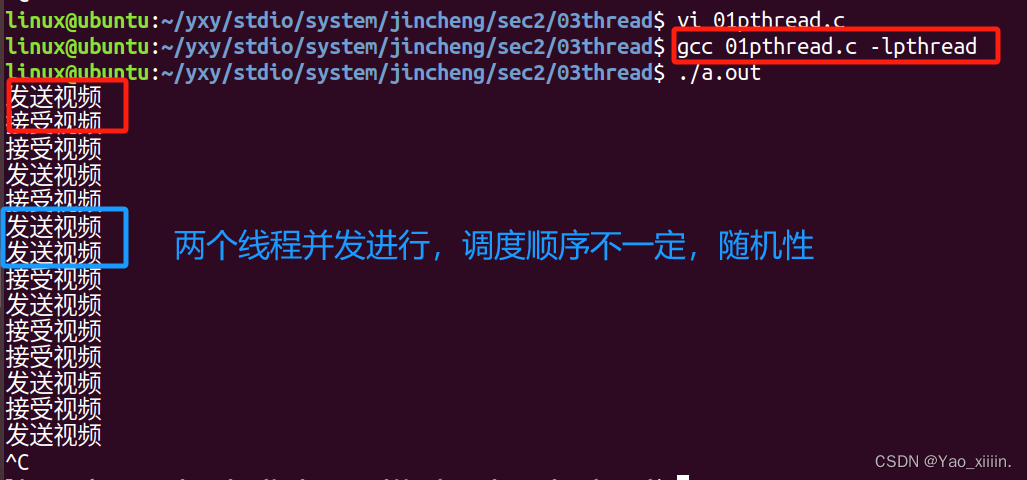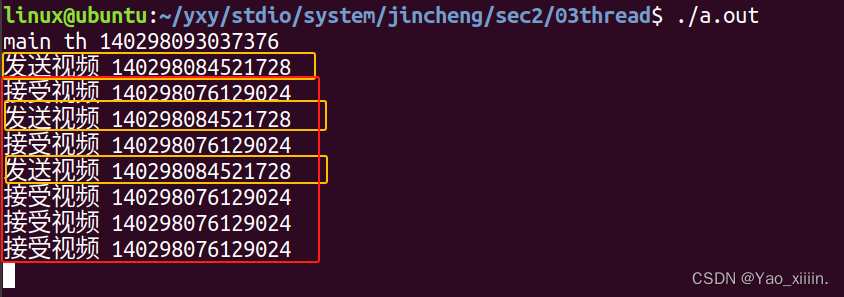一、pthread 线程
优点:
比多进程节省资源,可以共享变量。
概念:
线程是轻量级进程,一般是一个进程中的多个任务。
进程是系统中最小的资源分配单位.
线程是系统中最小的执行单位
特征:
1、共享资源
2、效率高 30%
3、三方库: pthread clone posix
3.1 编写代码头文件: pthread.h
3.2 编译代码加载库: -lpthread library
libpthread.so //库文件命名
gcc 1.c -lpthread //编入库
缺点:
1、线程和进程相比,稳定性,稍微差些
2、线程的调试gdb,相对麻烦些。
info thread
*1
2
3
thread 3
线程与进程区别:
1、资源:
线程比进程多了共享资源。 IPC
线程(8M)又具有部分私有资源(各自的栈)。
进程(3G)间只有私有资源没有共享资源。
2、 空间:
进程空间独立,不能直接通信。
线程可以共享空间,可以直接通信
3、进程---复杂问题
线程---简单问题
4、线程属于某个进程
线程与进程共同处:
1、并发
二、线程的设计框架 posix
创建多线程 ==》线程空间操作 ===》线程资源回收
errno strerror(errno) perror();
1、创建多线程
2.1.1 pthread_create
int pthread_create(pthread_t *thread, const pthread_attr_t *attr,
void *(*start_routine) (void *), void *arg);
功能:该函数可以创建指定的一个线程。
参数:thread 线程id,需要实现定义并由该函数返回。
attr 线程属性,一般是NULL,表示默认属性。
start_routine 指向指针函数的函数指针。
本质上是一个函数的名称即可。称为
th 回调函数,是线程的执行空间。
{
}
arg 回调函数的参数,即参数3的指针函数参数。
返回值:成功 0
失败 非0错误码
#include <stdio.h>
#include <stdlib.h>
#include <unistd.h>
#include <string.h>
#include <pthread.h>
void *th1 (void*arg)
{while(1){printf("发送视频\n");sleep(1);}
}void *th2 (void*arg)
{while(1){printf("接受控制\n");sleep(1);}
}int main(int argc, char *argv[])
{pthread_t tid1,tid2;pthread_create(&tid1,NULL,th1,NULL);pthread_create(&tid1,NULL,th2,NULL);while(1);return 0;
}
2.1.2 注意:
一次pthread_create 执行只能创建 一个线程。
每个进程 至少有一个线程 称为 主线程。
主线程退出 则 所有创建的子线程都退出。
主线程 必须有 子线程同时运行 才算 多线程程序。
线程id 是线程的 唯一标识,是CPU维护的一组数字。
pstree 查看系统中 多线程的对应关系。
多个子线程 可以 执行同一回调函数。
ps -eLf 查看线程相关信息 Low Weigth Process
ps -eLo pid,ppid,lwp,stat,comm
2.1.3 pthread_self
pthread_t pthread_self(void); unsigned long int; %lu (printf("%lu",pthread_self());)
功能:获取当前线程的线程id
参数:无
返回值:成功 返回当前线程的线程id
失败 -1;
syscall(SYS_gettid);
这个方法重启后失效
alias gcc='gcc -g -pthread '
unalias gcc
#include <stdio.h>
#include <stdlib.h>
#include <unistd.h>
#include <string.h>
#include <pthread.h>
void *th1 (void*arg)
{while(1){printf("发送视频 %lu\n",pthread_self());sleep(1);}
}void *th2 (void*arg)
{while(1){printf("接受控制 %lu\n",pthread_self());sleep(1);}
}int main(int argc, char *argv[])
{pthread_t tid1,tid2;pthread_create(&tid1,NULL,th1,NULL);pthread_create(&tid2,NULL,th2,NULL);printf("main th %lu\n",pthread_self());while(1);return 0;
}
2、线程的退出
2.2.1 pthread_exit
自行退出 ==》自杀 ==》子线程自己退出
exit(1);
void pthread_exit(void *retval); exit return p;
功能:子线程自行退出
参数: retval 线程退出时候的返回状态,临死遗言。
返回值:无
th
{
int a =10;
pthread_exit(&a);
}
join(,&ret)
#include <stdio.h>
#include <stdlib.h>
#include <unistd.h>
#include <string.h>
#include <pthread.h>
void *th1 (void*arg)
{int i =3;while(i--){printf("发送视频 %lu\n",pthread_self());sleep(1);}pthread_exit(NULL);//return NULL;
}void *th2 (void*arg)
{int i = 3;while(i--){printf("接受控制 %lu\n",pthread_self());sleep(1);}pthread_exit(NULL);
}int main(int argc, char *argv[])
{pthread_t tid1,tid2;pthread_create(&tid1,NULL,th1,NULL);pthread_create(&tid2,NULL,th2,NULL);printf("main th %lu\n",pthread_self());while(1);return 0;
}

2.2.2 pthread_cancel
强制退出 ==》他杀 ==》主线程结束子线程
int pthread_cancel(pthread_t thread);
功能:请求结束一个线程
参数:thread 请求结束一个线程tid
返回值:成功 0
失败 非0错误号;
#include <stdio.h>
#include <stdlib.h>
#include <unistd.h>
#include <string.h>
#include <pthread.h>
void *th1 (void*arg)
{while(1){printf("发送视频\n");sleep(1);}
}void *th2 (void*arg)
{while(1){printf("接受控制\n");sleep(1);}
}int main(int argc, char *argv[])
{pthread_t tid1,tid2;pthread_create(&tid1,NULL,th1,NULL);pthread_create(&tid2,NULL,th2,NULL);int i = 0 ;while(1){i++;if(3 == i ){pthread_cancel(tid1);}if(5 ==i){pthread_cancel(tid2);}sleep(1);}return 0;
}
(时间可能不准确,大致3s关,5s关,线程同时走)每次结果可能都不一样

3、线程的回收
2.3.1 线程的回收机制
====》不同与进程没有孤儿线程和僵尸线程。
====》主线程结束任意生成的子线程都会结束。
====》子线程的结束不会影响主线程的运行。
char * retval ; retval++; 1
int * retval;
2.3.2 pthread_join
int pthread_join(pthread_t thread, void **retval);
功能:通过该函数可以将指定的线程资源回收,该函数具有阻塞等待功能,如果指定的线程没有 结束,则回收线程会阻塞。(如果子线程没有回收成功,主线程不会执行后面的代码)
参数:thread 要回收的子线程tid
retval 要回收的子线程返回值/状态。==》ptread_exit(值);
返回值:成功 0
失败 非0错误号;
#include <stdio.h>
#include <stdlib.h>
#include <unistd.h>
#include <string.h>
#include <pthread.h>
void *th1 (void*arg)
{int i = 3;while(i--){printf("发送视频\n");sleep(1);}
}void *th2 (void*arg)
{int i = 3;while(i--){printf("接受控制\n");sleep(1);}
}int main(int argc, char *argv[])
{pthread_t tid1,tid2;pthread_create(&tid1,NULL,th1,NULL);pthread_join(tid1,NULL);pthread_join(tid2,NULL);printf("子线程已被回收\n");return 0;
}
join接收返回值
#include <stdio.h>
#include <stdlib.h>
#include <string.h>
#include <unistd.h>
#include <pthread.h>void* th(void* arg)
{static char buf[256]={0};strcpy(buf,"要消亡了\n");return buf;
}int main(int argc, char *argv[])
{pthread_t tid;void* ret;pthread_create(&tid,NULL,th,NULL);pthread_join(tid,&ret);printf("ret %s\n",(char*)ret);return 0;
} 
#include <stdio.h>
#include <stdlib.h>
#include <string.h>
#include <unistd.h>
#include <pthread.h>void* th(void* arg)
{static int a =20;return &a;
}int main(int argc, char *argv[])
{pthread_t tid;void* ret;pthread_create(&tid,NULL,th,NULL);pthread_join(tid,&ret);printf("ret %d\n",*(int*)ret);return 0;
}
2.3.3 子线程的回收策略
1)如果预估 子线程可以有限范围内结束 则 正常用pthread_join等待回收。
2)如果预估 子线程可能休眠 或者 阻塞 则 等待一定时间后 强制回收。
3)如果子线程已知 必须长时间运行 则 不再回收其资源。
4、线程的参数,返回值
5、线程的清理(成对使用)
2.5.1 cleanup_push
void pthread_cleanup_push(void (*routine)(void *),void *arg);//相当于do while 中的 do
功能:注册一个线程清理函数
参数:routine,线程清理函数的入口
arg,清理函数的参数
返回值:无
2.5.2 cleanup_pop
void pthread_cleanup_pop(int execute);//相当于do while 中的 while
功能:调用清理函数
参数: execute,非0 执行清理函数
0 不执行清理
返回值:无
#include <stdio.h>
#include <stdlib.h>
#include <unistd.h>
#include <pthread.h>
#include <string.h>void clean(void* arg)
{printf("this is clean ,arg is %s\n",(char*)arg);free(arg);
}
void* th(void*arg)
{pthread_cleanup_push(clean,arg);printf("th arg is %s\n",(char*)arg);pthread_cleanup_pop(1);return NULL;
}int main(int argc, char *argv[])
{pthread_t tid;char* p = (char*)malloc(50);strcpy(p,"hello");pthread_create(&tid,NULL,th,p);pthread_join(tid,NULL);return 0;
}








)

Mac上打开Android模拟器导致声音变了的解决方法)




)



编辑 4 行事件)